KIA CARENS RHD 2017 Owner's Guide
Manufacturer: KIA, Model Year: 2017, Model line: CARENS RHD, Model: KIA CARENS RHD 2017Pages: 723, PDF Size: 40.8 MB
Page 31 of 723
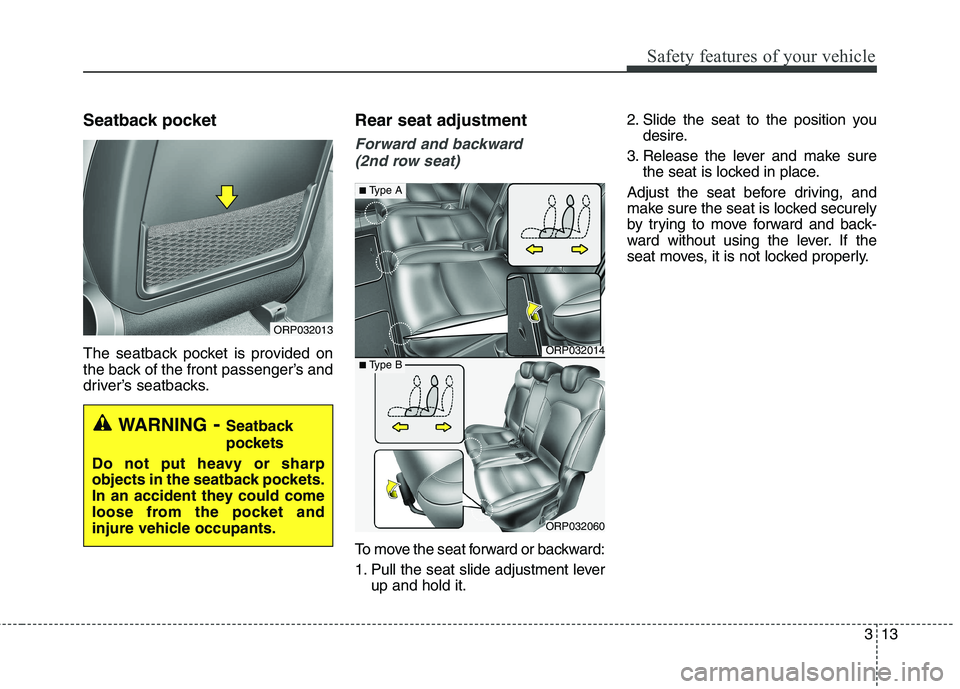
313
Safety features of your vehicle
Seatback pocket
The seatback pocket is provided on
the back of the front passenger’s and
driver’s seatbacks.Rear seat adjustment
Forward and backward
(2nd row seat)
To move the seat forward or backward:
1. Pull the seat slide adjustment lever up and hold it. 2. Slide the seat to the position you
desire.
3. Release the lever and make sure the seat is locked in place.
Adjust the seat before driving, and
make sure the seat is locked securely
by trying to move forward and back-
ward without using the lever. If the
seat moves, it is not locked properly.
ORP032014
ORP032060
■ Type A
■Type B
ORP032013
WARNING - Seatback
pockets
Do not put heavy or sharp
objects in the seatback pockets.
In an accident they could come
loose from the pocket and
injure vehicle occupants.
Page 32 of 723
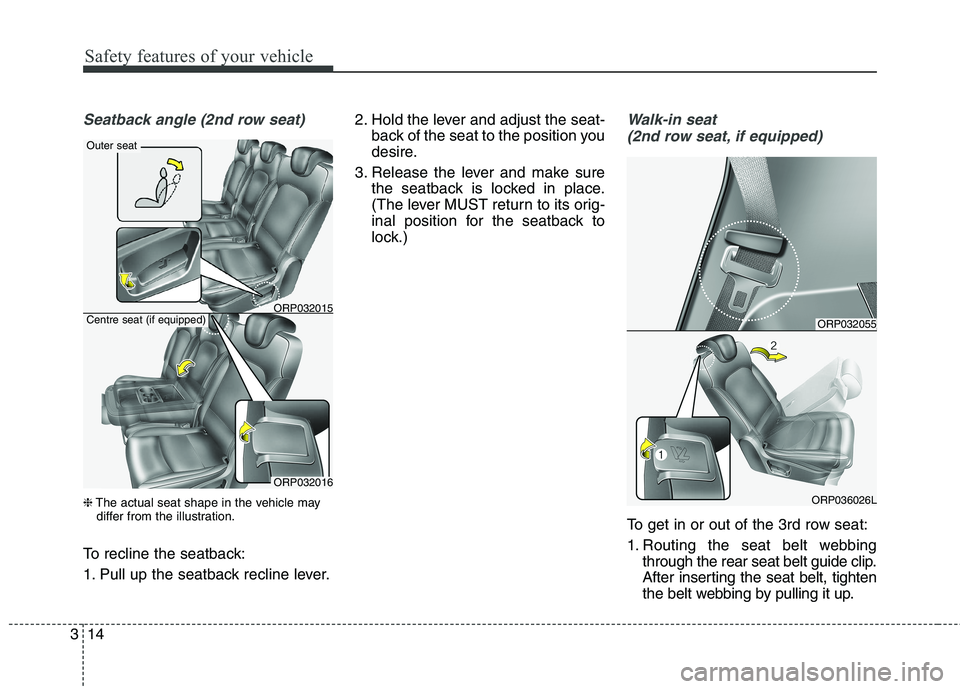
Safety features of your vehicle
14
3
Seatback angle (2nd row seat)
❈ The actual seat shape in the vehicle may
differ from the illustration.
To recline the seatback:
1. Pull up the seatback recline lever. 2. Hold the lever and adjust the seat-
back of the seat to the position you
desire.
3. Release the lever and make sure the seatback is locked in place.
(The lever MUST return to its orig-
inal position for the seatback to
lock.)
Walk-in seat
(2nd row seat, if equipped)
To get in or out of the 3rd row seat:
1. Routing the seat belt webbing through the rear seat belt guide clip.
After inserting the seat belt, tighten
the belt webbing by pulling it up.
ORP032055
ORP036026L
ORP032016
ORP032015
Outer seat
Centre seat (if equipped)
Page 33 of 723
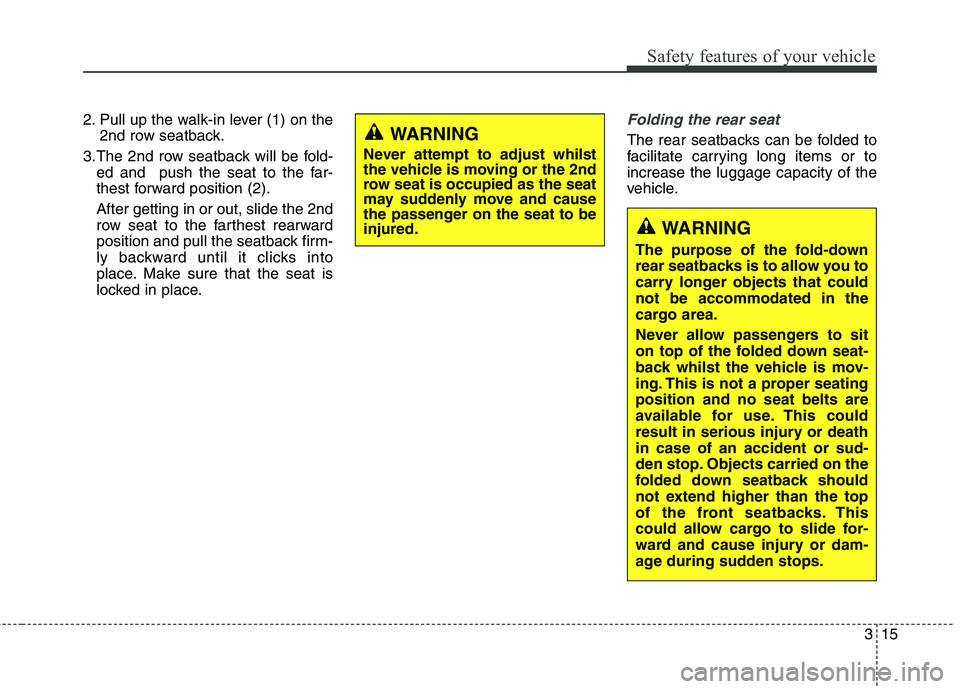
315
Safety features of your vehicle
2. Pull up the walk-in lever (1) on the2nd row seatback.
3.The 2nd row seatback will be fold- ed and push the seat to the far-
thest forward position (2). After getting in or out, slide the 2nd
row seat to the farthest rearward
position and pull the seatback firm-
ly backward until it clicks into
place. Make sure that the seat is
locked in place.Folding the rear seat
The rear seatbacks can be folded to
facilitate carrying long items or toincrease the luggage capacity of the
vehicle.
WARNING
The purpose of the fold-down
rear seatbacks is to allow you to
carry longer objects that couldnot be accommodated in the
cargo area.
Never allow passengers to sit
on top of the folded down seat-
back whilst the vehicle is mov-
ing. This is not a proper seatingposition and no seat belts are
available for use. This could
result in serious injury or deathin case of an accident or sud-
den stop. Objects carried on the
folded down seatback should
not extend higher than the top
of the front seatbacks. This
could allow cargo to slide for-
ward and cause injury or dam-
age during sudden stops.
WARNING
Never attempt to adjust whilst
the vehicle is moving or the 2nd
row seat is occupied as the seat
may suddenly move and cause
the passenger on the seat to beinjured.
Page 34 of 723
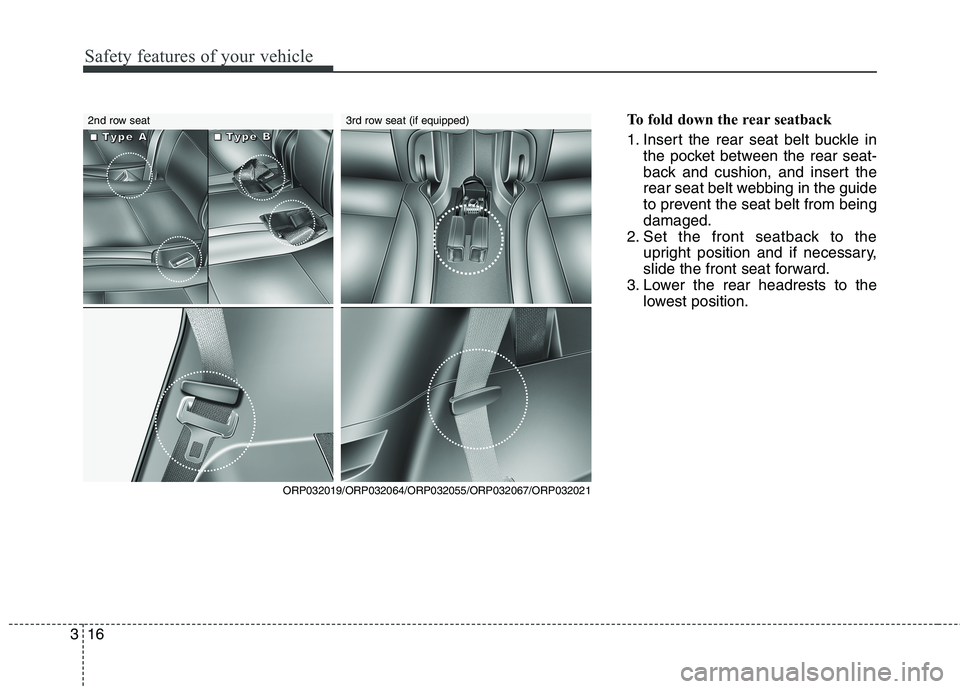
Safety features of your vehicle
16
3
To fold down the rear seatback
1. Insert the rear seat belt buckle in
the pocket between the rear seat-
back and cushion, and insert the
rear seat belt webbing in the guide
to prevent the seat belt from beingdamaged.
2. Set the front seatback to the upright position and if necessary,
slide the front seat forward.
3. Lower the rear headrests to the lowest position.2nd row seat3rd row seat (if equipped)
ORP032019/ORP032064/ORP032055/ORP032067/ORP032021
■■■■TTTTyyyyppppeeee AAAA■■■■TTTTyyyyppppeeee BBBB
Page 35 of 723

317
Safety features of your vehicle
4.Pull on the seatback folding leveror strap, then fold the seat toward
the front of the vehicle. When you
return the seatback to its upright
position, always be sure it has
locked into position by pushing on
the top of the seatback.
5.To use the rear seat, lift and pull the seatback backward by pulling
on the folding lever or strap.
Pull the seatback firmly until it
clicks into place.
Make sure the seatback is locked
in place.
6.Return the rear seat belt to the proper position.2nd row seat
ORP032022/ORP032062/ORP032023/ORP032063
❈The actual seat shape in the vehicle may differ from the illustration.
■Type A■ Type B
3rd row seat (if equipped)
ORP032024/ORP032025
■Type A ■
Type B
Page 36 of 723
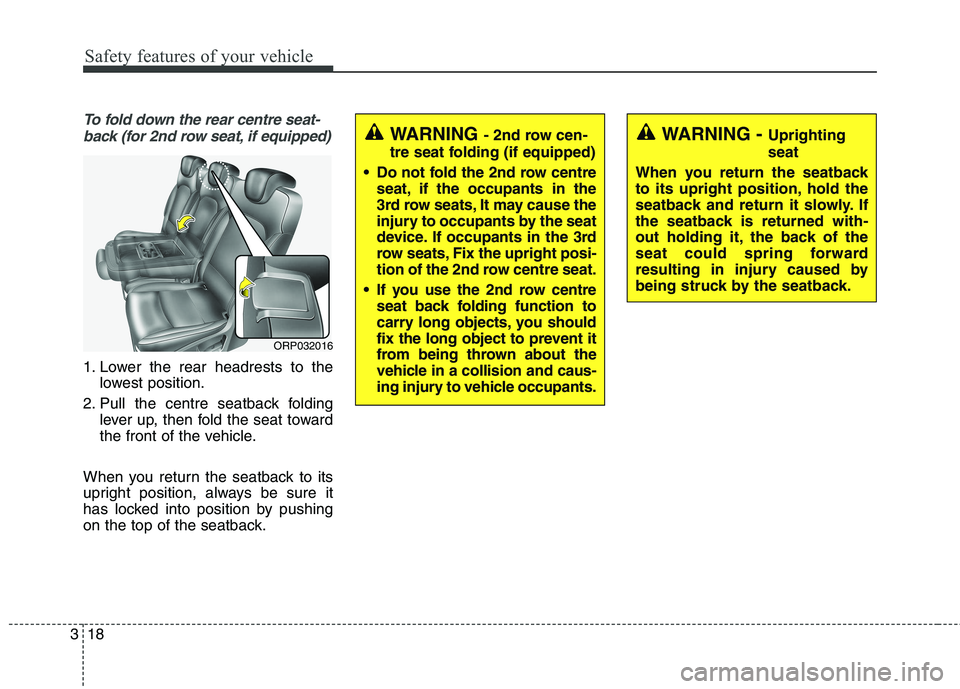
Safety features of your vehicle
18
3
To fold down the rear centre seat-
back (for 2nd row seat, if equipped)
1. Lower the rear headrests to the lowest position.
2. Pull the centre seatback folding lever up, then fold the seat toward
the front of the vehicle.
When you return the seatback to its
upright position, always be sure it
has locked into position by pushing
on the top of the seatback.
ORP032016
WARNING - 2nd row cen-
tre seat folding (if equipped)
Do not fold the 2nd row centre seat, if the occupants in the
3rd row seats, It may cause the
injury to occupants by the seat
device. If occupants in the 3rd
row seats, Fix the upright posi-
tion of the 2nd row centre seat.
If you use the 2nd row centre seat back folding function to
carry long objects, you should
fix the long object to prevent it
from being thrown about the
vehicle in a collision and caus-
ing injury to vehicle occupants.WARNING - Uprighting seat
When you return the seatback
to its upright position, hold the
seatback and return it slowly. If
the seatback is returned with-
out holding it, the back of the
seat could spring forward
resulting in injury caused by
being struck by the seatback.
Page 37 of 723
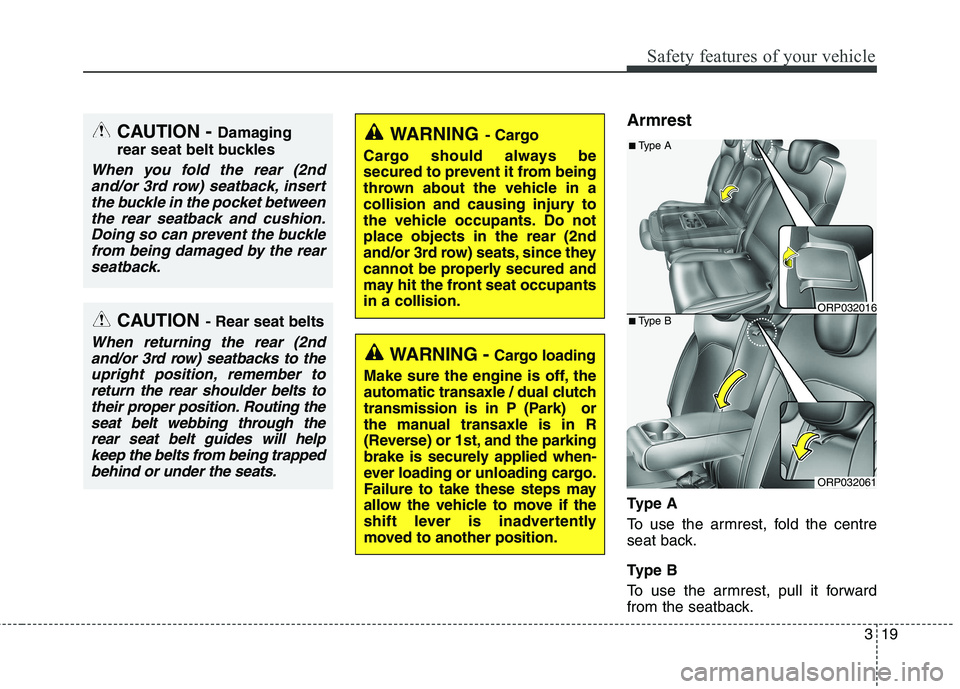
319
Safety features of your vehicle
Armrest
Ty p e A
To use the armrest, fold the centre
seat back.
Ty p e B
To use the armrest, pull it forward
from the seatback.
CAUTION- Rear seat belts
When returning the rear (2nd
and/or 3rd row) seatbacks to theupright position, remember to return the rear shoulder belts totheir proper position. Routing theseat belt webbing through the rear seat belt guides will helpkeep the belts from being trappedbehind or under the seats.
CAUTION - Damaging
rear seat belt buckles
When you fold the rear (2nd and/or 3rd row) seatback, insertthe buckle in the pocket between the rear seatback and cushion.Doing so can prevent the bucklefrom being damaged by the rear seatback.
WARNING - Cargo
Cargo should always be
secured to prevent it from being
thrown about the vehicle in a
collision and causing injury to
the vehicle occupants. Do notplace objects in the rear (2nd
and/or 3rd row) seats, since they
cannot be properly secured and
may hit the front seat occupantsin a collision.
WARNING - Cargo loading
Make sure the engine is off, the
automatic transaxle / dual clutch
transmission is in P (Park) or
the manual transaxle is in R
(Reverse) or 1st, and the parking
brake is securely applied when-
ever loading or unloading cargo.
Failure to take these steps may
allow the vehicle to move if the
shift lever is inadvertently
moved to another position.
ORP032061
ORP032016
■ Type A
■Type B
Page 38 of 723
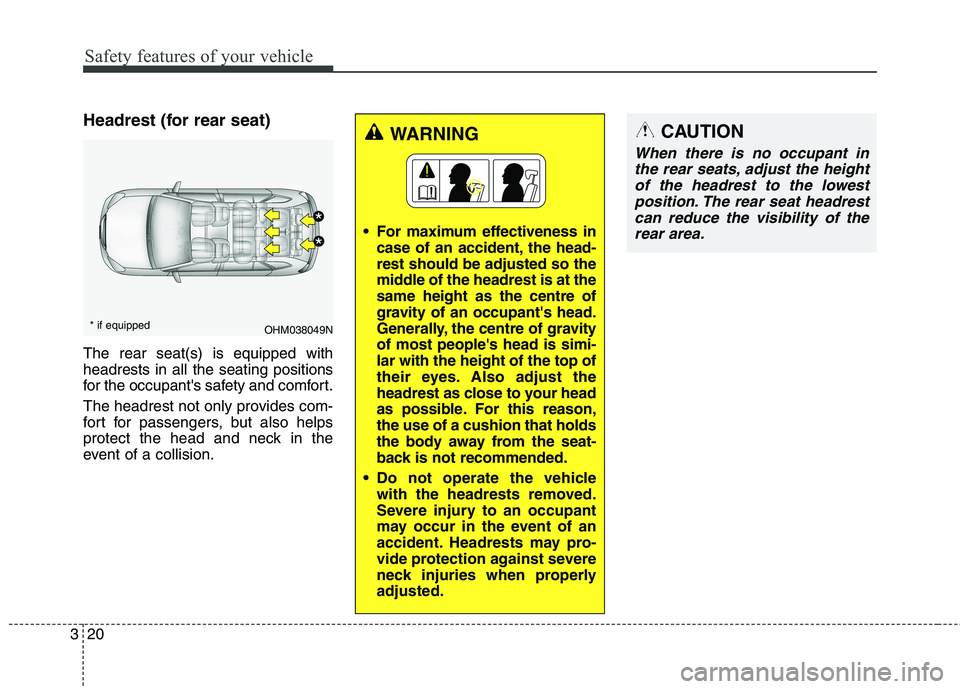
Safety features of your vehicle
20
3
Headrest (for rear seat) The rear seat(s) is equipped with headrests in all the seating positions
for the occupant's safety and comfort.
The headrest not only provides com-
fort for passengers, but also helps
protect the head and neck in the
event of a collision.
OHM038049N
*
*
* if equipped
WARNING
For maximum effectiveness in case of an accident, the head- rest should be adjusted so the
middle of the headrest is at thesame height as the centre of
gravity of an occupant's head.
Generally, the centre of gravityof most people's head is simi-lar with the height of the top of
their eyes. Also adjust the
headrest as close to your head
as possible. For this reason,the use of a cushion that holds
the body away from the seat-
back is not recommended.
Do not operate the vehicle with the headrests removed.
Severe injury to an occupant
may occur in the event of an
accident. Headrests may pro-
vide protection against severe
neck injuries when properlyadjusted.CAUTION
When there is no occupant in
the rear seats, adjust the heightof the headrest to the lowest position. The rear seat headrestcan reduce the visibility of therear area.
Page 39 of 723
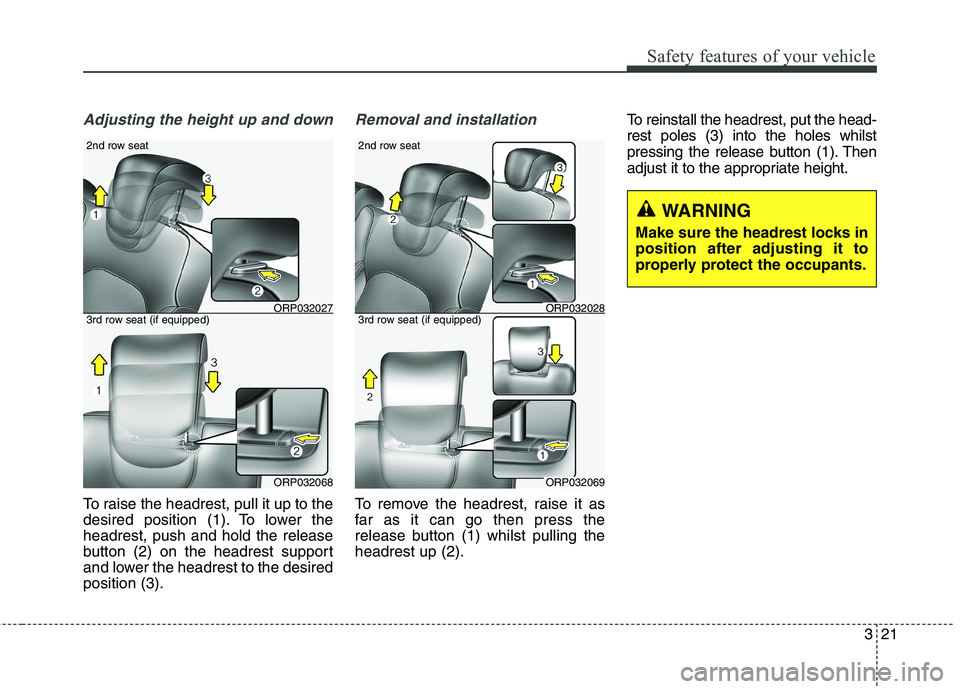
321
Safety features of your vehicle
Adjusting the height up and down
To raise the headrest, pull it up to the
desired position (1). To lower theheadrest, push and hold the release
button (2) on the headrest support
and lower the headrest to the desiredposition (3).
Removal and installation
To remove the headrest, raise it as
far as it can go then press the
release button (1) whilst pulling theheadrest up (2).To reinstall the headrest, put the head- rest poles (3) into the holes whilst
pressing the release button (1). Then
adjust it to the appropriate height.
WARNING
Make sure the headrest locks in position after adjusting it to
properly protect the occupants.
ORP032068
ORP032027
2nd row seat
3rd row seat (if equipped)
ORP032069
ORP032028
2nd row seat
3rd row seat (if equipped)
Page 40 of 723

Safety features of your vehicle
22
3
Seat belt restraint system SEAT BELTS(Continued)
Never wear the shoulder belt
under your arm or behind your
back. An improperly positionedshoulder belt can cause seri-
ous injuries in a crash. Theshoulder belt should be posi-
tioned midway over your shoul-
der across your collarbone.
Never wear a seat belt over fragile objects. If there is a
sudden stop or impact, the
seat belt can damage it.
Avoid wearing twisted seat belts. A twisted belt can't do
its job as well. In a collision, it
could even cut into you. Besure the belt webbing isstraight and not twisted.
Be careful not to damage the belt webbing or hardware. If
the belt webbing or hardware
is damaged, replace it.WARNING - Australian
design rules
Seat belts are designed to bear
upon the bony structure of the
body, and should be worn low
across the front of the pelvis or
the pelvis, chest and shoulders,
as applicable; wearing the lap
section of the belt across the
abdominal area must be avoided. Seat belts should be adjusted as
firmly as possible, consistent
with comfort, to provide the pro-
tection for which they have beendesigned.
A slack belt will greatly reduce
the protection afforded to the
wearer.
(Continued)
WARNING
For maximum restraint sys- tem protection, the seat belts
must always be used whenev-
er the car is moving.
Seat belts are most effective when seatbacks are in theupright position.
Children age 12 and younger must always be properlyrestrained in the rear seat.
Never allow children to ride in
the front passenger seat. If a
child over 12 must be seated in
the front seat, he/she must be
properly belted and the seat
should be mo ved as far back
as possible.
(Continued)